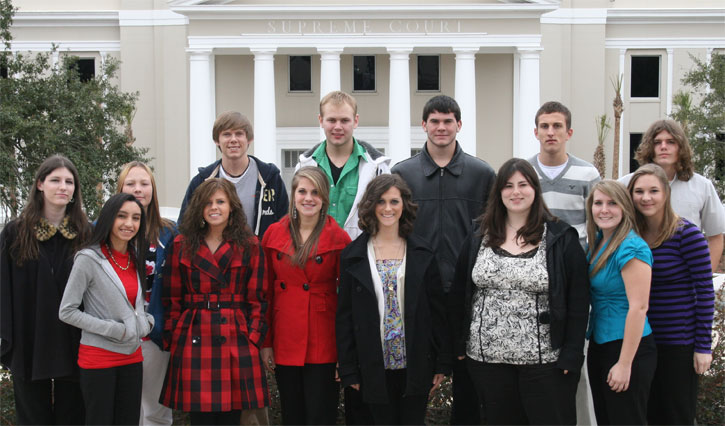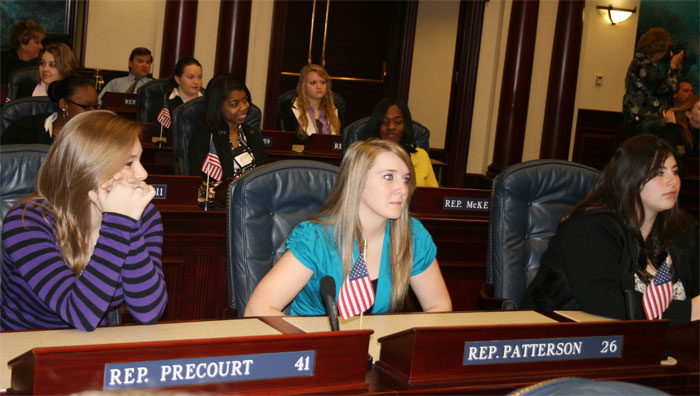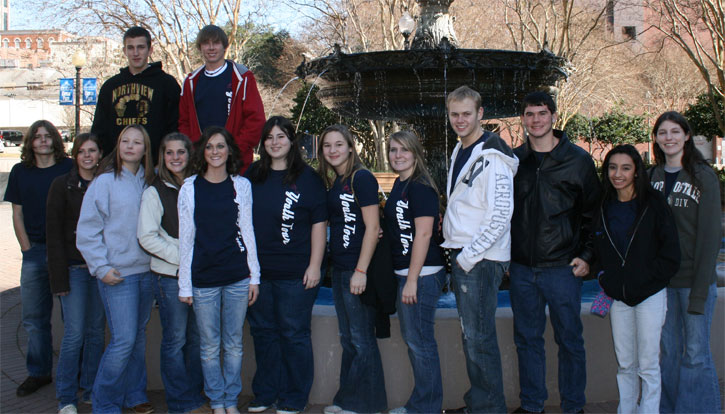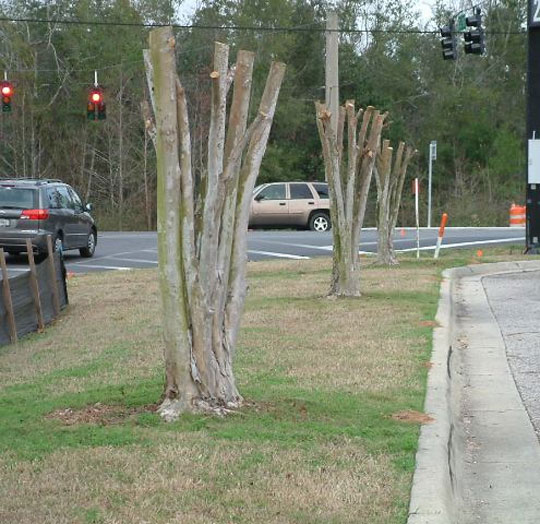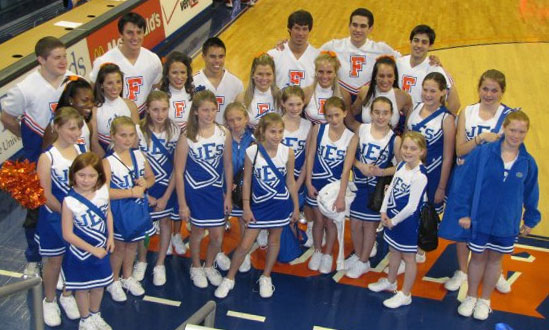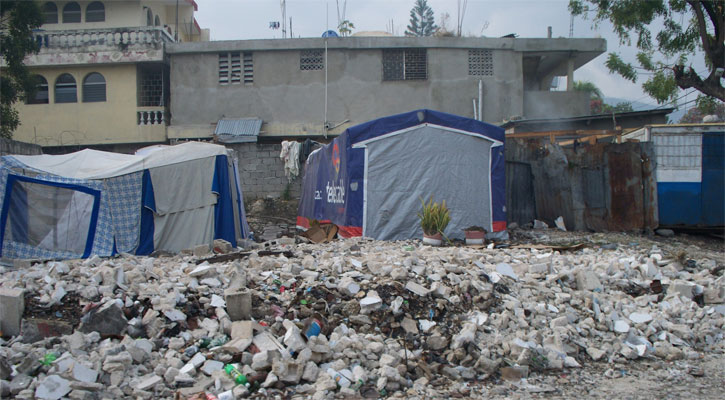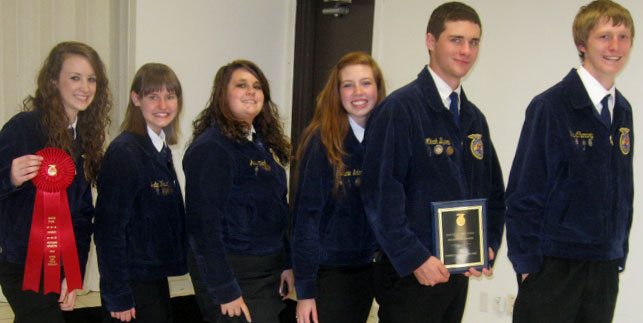Area Students Attend Youth Tour In Tallahassee
March 17, 2010
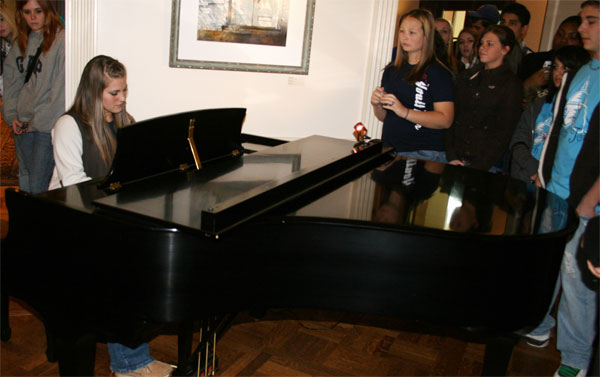 Escambia River Electric Cooperative recently gave 14 juniors from the EREC service area in Escambia and Santa Rosa counties an opportunity to take part in a youth tour of the state capital.
Escambia River Electric Cooperative recently gave 14 juniors from the EREC service area in Escambia and Santa Rosa counties an opportunity to take part in a youth tour of the state capital.
The students traveled with EREC to Tallahassee to learn more about their state legislature and electric cooperatives. Participants included Allie Bryan, Taylor Fisher, Alexis Harris, Anna Hollingshead, Sarah Killam, A.J. Lambert, Sarah McLean, Nick McMellon, Courtney Penton, Justin Poley, Josh Scott, Ashley Stokes, Leely Trevino and Jami Wessel.
While in Tallahassee, the students toured the governor’s mansion and observed court in session in the Florida Supreme Court. The students participated in a mock session in the house chambers where various members of the House of Representatives addressed the group. In addition, the students enjoyed visiting the Challenger Museum and viewing the IMAX movie, Forces of Nature.
The Youth Tour program provides students an opportunity to learn more about their state government and electric cooperatives and also gives them a chance to interact with other students from co-ops throughout the state. It was a great educational experience and a lot of fun for the entire group, according to Sabrina Owens, EREC spokesperson.
Pictured above: Youth Tour participants on the steps of the capital and in front of the Florida Supreme Court. (Front, L-R) Leely Trevino, Alexis Harris, Sarah Killam, Allie Bryan, Sarah McLean, Courtney Penton and Jami Wessel. Back row: Anna Hollingshead, Ashley Stokes, Josh Scott, Nick McMellon, Justin Poley, A.J. Lambert and Taylor Fisher. Pictured inset: Sarah Killam plays the piano in the Governor’s Mansion. Pictured below: Jami Wessel, Courtney Penton and Sarah McLean participate in a mock session in the House of Representatives. Pictured bottom: EREC Youth Tour participants in Tallahassee. Submitted photos for NorthEscambia.com, click to enlarge.
1,156 ‘Buckets Of Hope’ Headed From North Escambia To Haiti
March 16, 2010
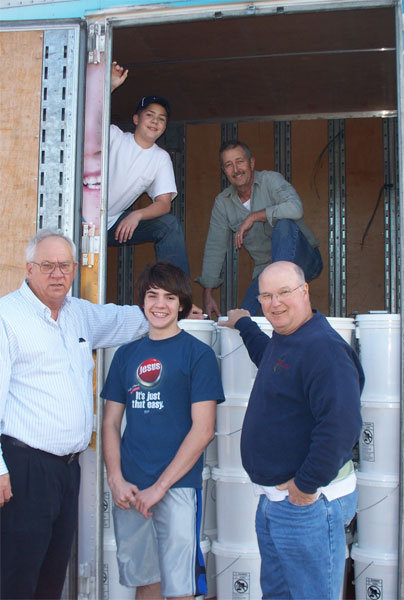 Over 1,100 food-containing Buckets of Hope were donated by North Escambia area residents to help the victims of the Haiti earthquake.
Over 1,100 food-containing Buckets of Hope were donated by North Escambia area residents to help the victims of the Haiti earthquake.
The 1,156 buckets were donated in just over a month at host site First Baptist Church of Cantonment as well as the First Baptist Church of Bratt, area schools and other drop-off points. The buckets contain specific food items, including beans, rice, sugar, flour, cooking oil and other essentials. Each bucket contains enough food to feed a family of four for about a week, plus they have the bucket to reuse to haul water, store food items or even move rubble in the earthquake stricken land.
Monday, the buckets were loaded a trailer donated by Gilmore Services. The company will transport the buckets to Marianna to be made ready for delivery to Haiti.
Pictured top: Volunteers load over 1,100 Buckets of Hope into a Gilmore Services trailer Monday in Cantonment. Pictured inset: First Baptist Church of Cantonment Associate Pastor Larry Huff, Marc Wilson, Ottoway Fillingim, Dalton Smith and Dylan Smith. Submitted photos for NorthEscambia.com, click to enlarge.
Thinking Outside The Box: Area Couple Builds Dome Home
March 15, 2010
Energy efficiency is a hot topic these days, with many people thinking of ways to cut energy costs more than ever before. When Charlie and Margaret Simmons of New Iberia, Louisiana, decided to move back to Margaret’s hometown of Jay and build their retirement home, energy efficiency was an important factor in choosing the style of house they would construct. However, there were additional features that prompted them to ultimately choose to build a monolithic dome home.
A monolithic (one-piece) dome is an extremely energy efficient, steel-reinforced concrete structure that can basically be designed for any type of use. The dome structure starts with a reinforced concrete tension ring to which a plasticized airform (balloon) is attached and inflated. All subsequent work is done inside the airform. First, three to four inches of foam is sprayed on the interior. This is followed by a steel rebar structure and then covered with concrete, six inches at the base and about three inches at the apex. Having the insulation on the outside is non-traditional but as Charlie Simmons explained, “That is where God put it on sheep.”
 The curved shape of the exterior structure actually reflects energy away. The multiple tons of concrete provide a very stable and well-insulated interior, which in turn, absorbs energy and keeps the temperature relatively constant. The insulation does not deteriorate with time, moisture or compaction. The dome provides a solid thermal envelope and the airtight exterior affords no, or minuscule at most, energy leakage. The dome is so well insulated that fresh outdoor air must be brought in through an air-to-air heat exchanger to minimize energy loss and a HEPA (99.9% efficiency) air filter to take out contaminates. This preconditioned, filtered, pressurized air enters the HVAC system for normal distribution. The pressurization prevents dust from entering even when doors are opened. This feature is especially appealing to Margaret Simmons.
The curved shape of the exterior structure actually reflects energy away. The multiple tons of concrete provide a very stable and well-insulated interior, which in turn, absorbs energy and keeps the temperature relatively constant. The insulation does not deteriorate with time, moisture or compaction. The dome provides a solid thermal envelope and the airtight exterior affords no, or minuscule at most, energy leakage. The dome is so well insulated that fresh outdoor air must be brought in through an air-to-air heat exchanger to minimize energy loss and a HEPA (99.9% efficiency) air filter to take out contaminates. This preconditioned, filtered, pressurized air enters the HVAC system for normal distribution. The pressurization prevents dust from entering even when doors are opened. This feature is especially appealing to Margaret Simmons.
A beneficial effect of this super-insulated home is downsized heat and air equipment. The Simmons’ home is 3,400 sq. ft. and a 1 ½ ton A/C unit adequately services the entire structure. A traditionally constructed home of this same size would most likely require a 5 to 6 ton A/C unit. According to C. Simmons, “The efficiency of the house appeals to me as an engineer, and I like having something that is a little different, too.”
 Durability is another feature that attracted Simmons to the dome structure. Simmons commented that the model he chose to construct was tested in a wind tunnel at Texas A&M University to withstand 600 mph winds. The strongest hurricane winds recorded to date have been slightly over 200 mph and tornado winds at just over 300 mph. Typically during violent storms such as hurricanes and tornadoes, high winds acting on flat surfaces and negative air pressure combine and can get under the eves and soffits of a conventional house. This force, in turn, may cause the roof to be ripped off the house. The aerodynamic shape of the dome provides excellent above ground protection against powerful winds in any direction, allowing the wind’s energy to glide past without causing damage to the basic structure. Even sounds from the outside are virtually eliminated.
Durability is another feature that attracted Simmons to the dome structure. Simmons commented that the model he chose to construct was tested in a wind tunnel at Texas A&M University to withstand 600 mph winds. The strongest hurricane winds recorded to date have been slightly over 200 mph and tornado winds at just over 300 mph. Typically during violent storms such as hurricanes and tornadoes, high winds acting on flat surfaces and negative air pressure combine and can get under the eves and soffits of a conventional house. This force, in turn, may cause the roof to be ripped off the house. The aerodynamic shape of the dome provides excellent above ground protection against powerful winds in any direction, allowing the wind’s energy to glide past without causing damage to the basic structure. Even sounds from the outside are virtually eliminated.
 The durability attribute is also evidenced by its resistance to other forces of nature such as earthquakes, fire, and insects. The monolithic design of the dome has an even distribution of weight and a low center of gravity so that it actually moves with the earth. This design prevents the dome from damage, whereas, a traditional home can be shaken off its foundation as it wobbles with the earth’s lateral shifts in an earthquake.
The durability attribute is also evidenced by its resistance to other forces of nature such as earthquakes, fire, and insects. The monolithic design of the dome has an even distribution of weight and a low center of gravity so that it actually moves with the earth. This design prevents the dome from damage, whereas, a traditional home can be shaken off its foundation as it wobbles with the earth’s lateral shifts in an earthquake.
Neither is fire a detriment to the home. The exterior of the home is painted with a silicon based GE (General Electric Company) paint that will withstand 550 degrees F. and the concrete used in construction doesn’t burn. Nor are pests such as termites a concern because there is no wood in the structure for the termites to eat. Because of the dome’s resistance to weather, fire, and insects, the structure virtually has a lifespan of centuries rather than years. As a result, home insurance costs are greatly reduced.
The dome house’s economic feasibility is another appealing characteristic. Because of the limited number of components used in the structure itself, the cost is about the same as a conventional home of the same size. The dome’s shape, design, and quality of construction materials keep required future upkeep and maintenance virtually nonexistent.
 The Simmons decided a dome house would best meet their needs for a retirement home. Construction began in April of 2008 and was completed in November of 2009. Living in Louisiana during the various construction phases of the home could have posed complications for Simmons; however, local Virgle Bedsole served as project manager and could oversee the day to day operations of the home’s development. Bedsole says, “This project has been different from building a conventional house. Each step along the way, you have to think things through carefully, not just handle it the usual way.”
The Simmons decided a dome house would best meet their needs for a retirement home. Construction began in April of 2008 and was completed in November of 2009. Living in Louisiana during the various construction phases of the home could have posed complications for Simmons; however, local Virgle Bedsole served as project manager and could oversee the day to day operations of the home’s development. Bedsole says, “This project has been different from building a conventional house. Each step along the way, you have to think things through carefully, not just handle it the usual way.”
The interior of the home is beautiful with its teak wood flooring, cabinets and doors made of cypress salvaged from an old plantation home, and spacious floor plan. In addition, the home also features energy efficient LED lighting and the latest technological advancements. The Simmons seem to have thought of everything in regards to constructing a home they can enjoy for many years to come.
Pictured top: The Charlie and Margaret Simmons monolithic dome home in Jay. Pictured top inset: The dome’s airform fully inflated. Pictured middle inset: The garage entrance area of the home near competition. Pictured bottom inset: The kitchen area of the home. Submitted photos by Sabrina Owens for NorthEscambia.com, click to enlarge.
Stop Crape Murder: Don’t Cut Back Your Myrtles
March 14, 2010
Crape myrtles are a favorite tree along the Gulf Coast. It seems that every yard has at least one tree and landscapers frequently rely on these flowering trees for street plantings and commercial properties. Crape myrtles are low maintenance plants that reward us with colorful flowers throughout the summer months.
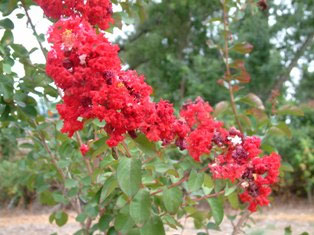 Flowers are not the only virtue of this tree. Many varieties have beautiful bark and growth habits that can be enjoyed all year if trees are not heavily pruned.
Flowers are not the only virtue of this tree. Many varieties have beautiful bark and growth habits that can be enjoyed all year if trees are not heavily pruned.
Unfortunately, many crape myrtles receive unnecessary pruning every winter in the form of topping or hat-racking. The practice of topping trees is so common that many people believe it to be needed in order for the tree to flower heavily. This is not always true.
Crape myrtles bloom on new growth which will occur without any pruning. Trees will continue to flower without topping and we all can then enjoy the natural shape and shade that the trees provide. Less pruning also saves the need to dispose of all the trimmings and may reduce your need for pesticides to manage unsightly powdery mildew or sooty mold. If you are pruning because your tree is too large for it’s spot, consider removing it and planting a tree or shrub that fits that spot.
There is a crape myrtle for any spot. Crape myrtles cultivars range in size from 1 foot to over 20 feet tall. Shop carefully so that you purchase a suitable plant for your landscape. The publication Crape Myrtle in Florida will help in your selection process.
Pictured top: Crape myrtle trees do not need pruning for new growth. Pictured below: These Crape myrtles were ruined with unnecessary topping. Submitted photos for NorthEscambia.com.
Source: The Escambia County Extension Service
Flomaton, Atmore, Brewton To Celebrate Great Alabama Homecoming
March 11, 2010
Atmore, Flomaton and Brewton will join more than 200 towns and cities that will stage homecoming events and unveil historic markers in 2010 as part of the state’s tourism promotional campaign for 2010 — the “Year of Small Towns and Downtowns”.
Flomaton will celebrate a Homecoming Weekend October 22-24. Events will include a special halftime show at Flomaton High School’s homecoming game on Friday night, October 22. Open houses are planned at the brand new Flomaton Library, the award-winning Turtle Point Science Center, the Flomaton Area Railroad Museum, the Flomaton Fire Department and the Flomaton Chamber of Commerce.
Area churches are being asked to move their homecoming celebrations to the weekend, and the First Baptist Church has already done so, according to Betty Jones, chairperson of the Flomaton 2010 Committee. The weekend will also feature a car show at Flomaton’s Lions Park, a vendors area downtown, music and more.
“We want everyone to come home to celebrate small towns and downtowns with us — the places we grew up and the backbone of the country we call home,” Jones said.
Vendor applications will be available at Flomaton’s Welcome Center for those interesting in selling their wares on October 23.
Atmore will take part in the Year of Small Towns and Downtowns with the annual Williams Station Day on October 23.
During Williams Station Day, Atmore residents and guests will turn back their clocks to 1866 when their community was named Williams Station – just a supply stop along the Mobile & Great Northern railroad. It was a simpler time, when life revolved around the railroads and folks marked time by the sound of the steam engines chugging through town or the whistle of the local lumber mill. We hope you’ll join us in Atmore for this regional festival that promises a fun day of family entertainment.
Williams Station Day is packed with great venues to fit every taste. For the young and young at heart we offer an old fashioned sampling of southern heritage seasoned with the blues, arts and crafts, cane milling and railroad memorabilia.
Williams Station Day will be October 23 from 9 a.m. until 5 p.m. To learn more, visit www.atmorechamber.com.
Brewton participate in the Great Alabama Homecoming on Saturday, June 19 at Burnt Corn Creek Park with the Alabama Blueberry Festival. There will be original arts and crafts, live entertainment, an antique car show, a motorcycle show and ride, a children’s section, blueberries, blueberry bushes, cookbooks, T-shirts, and a food court with blueberry ice cream. To learn more, call (251) 867-3224 or visit www.AlabamaBlueberryFestival.com.
Statewide, Alabama homecoming events will continue through mid-December. Historic markers written by local historians and provided by the Alabama Tourism Department will be unveiled at the events.
“As someone who grew up in a small town in Alabama, I know there’s something special about them. They have a unique character and charm. But in Alabama, even our bigger cities have a small town feel. As Alabamians, we’re truly fortunate that many of our hometowns really are like Mayberry,” said Alabama Governor Bob Riley, referring to the fictitious small town that was the setting of the “Andy Griffith Show”.
 A total of 215 communities, ranging in size from Mooresville, population 54, to Birmingham, population 300,000, have scheduled events as part of the Year of Small Towns and Downtowns.
A total of 215 communities, ranging in size from Mooresville, population 54, to Birmingham, population 300,000, have scheduled events as part of the Year of Small Towns and Downtowns.
“It’s going to be a great time to reflect on the importance of our small towns and downtowns, and I believe when it’s all over, people throughout the state will come away with a greater appreciation for the special place we all call home,” Riley said.
The state Tourism Department has posted a list of towns and event dates on its homecoming web site at www.alabamahomecoming.com.
Pictured above: Alabama Governor Bob Riley announces The Great Alabama Homecoming. Submitted photo for NorthEscambia.com, click to enlarge.
Jay Elementary Cheerleaders Cheer For Florida Gators
March 11, 2010
The Jay Elementary Cheerleaders recently had the opportunity to cheer for the Florida Gators. The girls attended a Florida Lady Gators basketball game where they were greeted by the Gator cheerleaders and coach.
Members of the Jay Elementary cheerleaders are Sunny Maher, Courtney Walther, Taylor Scott,Danielle Harrington, Madison Edwards, Connor Andrews, Lexie Nash, Hope Miller, Megan Teevan, Rebecca Boutwell, Robin Green, Savannah Seevers, Courtney Walther, Amber Parker, Maci Holt and Launa Burkhead.
Pictured above: The Jay Elementary cheerleaders with the Florida Gator cheerleaders at a recent Lady Gators basketball game. Submitted photo for NorthEscambia.com, click to enlarge.
Try These Questions From An Actual Fifth Grade FCAT
March 10, 2010
As the FCAT continues in schools across North Escambia, we thought we would help you waste a little time by playing a game of “Are You Smarter Than a Fifth Grader?” with actual questions from past fifth grade FCATs.
Grab everybody around you and get ready. To play along and see how you might do on the fifth grade FCAT, you’ll need a piece of paper to record your answers to the following questions:
(1) Samantha baked a dessert for her class using the recipe shown below.
Samantha used the least amount of which ingredient?
CRANBERRY APPLE CRUNCH
- A. 3/4 cup chopped apples
- B. 1/2 cup oats
- C. 2/3 cup cranberry sauce
- D. 1/4 cup brown sugar
(2) Louie made 17 bag lunches for the school outing. If Louie
had made 4 more lunches, he would have made exactly
3 times as many bag lunches as Marc did. How many lunches did Marc make?
- A. 6
- B. 7
- C. 13
- D. 4
(3) Coach Neal is planning a track meet for 84 students. Each race has 3 teams,
with 4 runners on each team. How many races should Coach Neal plan so
that each student runs in exactly one race?
- A. 7
- B. 12
- C. 21
- D. 28
(4) Toshi wants to find out which after-school sport is most popular among all
the students at his elementary school. Which of these groups would be best
to survey in order to get this information?
- A. all students at the school
- B. all teachers at the school
- C. all fifth grade students at the school
- D. all parents of the students at the school
(5) The 1927 legislative session designated the mockingbird as the state bird of
Florida. The bird is about 10 inches long and has a wingspan of 15 inches.
Which fraction represents the mockingbird’s length compared to
its wingspan?
- A. 1/5
- B. 2/15
- C. 2/3
- D. 3/2
(6) Angie is flying to London, England, on a plane departing at 2:00 p.m. She is
required to be at the airport one and a half hours before the departure time and it takes her 45 minutes to get from her house to the airport. What is the latest time
Angie can leave her house to arrive at the airport at the required time?
- A. 11:45 am
- B. 12:30 am
- C. 1:15 pm
- D. 4:15 pm
(7) Melanie measured the mass of the textbooks in her backpack. Which unit of
measure best describes the mass of the textbooks?
- A. 3 grams
- B. 3 kilograms
- C. 3 metric tons
- D. 3 milligrams
(8) Marchelle built a rectangular wooden picture frame. The frame has a
perimeter of 130 inches and a width of 30 inches.
What is the height, in inches, of the picture frame?
- A. 30 inches
- B. 35 inches
- C. 10 inches
- D. 13 inches
(9) Sonya has to write the greatest four-digit number she can think of by
following these three rules:
1. Any digit 0 through 9 may be used.
2. Any digit may be used only once.
3. There must be an 8 in the tens place.
What is the greatest number Sonya could write by following the three rules?
- A. 9876
- B. 9786
- C. 8796
- D. 9867
For the next two questions, read the two selections in blue.
Betsy Brandon Meets the Betsy Brandon Meets the President
by M.V. Pollock
There was a flurry of excitement in the Brandon household early one morning in
1791. It was the day that General Washington, the president, was supposed to visit
Salisbury, North Carolina. For most of the people, it would be their only chance to
see anyone so important. Everybody planned to be there. Everybody, it seemed,
except fourteen-year-old Betsy, the oldest child of Squire Richard Brandon’s
family. Betsy had to stay at home to finish the chores.
“Ha! Betsy won’t get to see the president,” teased the younger children as they
climbed into the family buggy. Betsy tried to hide her disappointment as they rode
away.
But Betsy was not one to mope. She returned to the kitchen and washed the
breakfast dishes and swept the floor. Then she took her bonnet from the hook on
the back of the door. She was going outside to feed the chickens. But what was
that rumbling noise? It sounded like wheels, but not like those of her father’s
buggy. It seemed to come from the opposite direction.
Betsy hurried to the front door and peeked out. Her eyes grew wide. Coming
down the road that passed in front of the house was the most beautiful coach she
had ever seen. It was pale ivory and trimmed in gold.
As it came near, Betsy felt herself drawn down the pathway to get a better
view. The coach was decorated with elaborate scenes that reminded Betsy of the
four seasons. And it bore an impressive emblem, like a coat of arms.
Suddenly the driver pulled on the reins. “Whoa!” he said loudly. The ornate
harnesses tinkled musically as the four fine horses halted right in front of the gate
where Betsy stood.
Fearful, Betsy wanted to run, but she felt as if her feet were glued to the path.
The door of the coach opened, and a tall, handsome man in uniform stepped down.
He was almost as tall as her father. He tipped his hat and nodded in her direction.
Then another, even more handsome man stepped out. He was white haired and at
least six-feet-four. Surely they were men of importance on their way to Salisbury
to see the president.
“Good morning, miss,” said the white-haired man. His face was stern and
deeply lined, but his blue eyes were warm and friendly.
“Good morning, sir.” Betsy’s voice quavered when she spoke.
“Is your father home?”
“No, sir.”
“Is your mother home?”
As Betsy shook her head, her golden braids moved back and forth. “My family
all went to Salisbury to see the president,” she explained.
“Did you not wish to see the president, too?” The voice was kind.
“Oh yes, sir,” Betsy replied. “I wanted to see the president more than anything,
but I must stay here to do the chores.”
The two men exchanged amused glances. “If you will prepare breakfast for us,
I promise you will see the president before any of the others.”
Thinking that the president would soon pass by on his way to Salisbury, Betsy
hurried into the kitchen. She prepared a delicious breakfast, which the two men
seemed to enjoy.
They thanked her and prepared to leave. Betsy asked, “Sir, when my family
returns, to whom shall I say I served breakfast?”
The white-haired man climbed inside the coach. Leaning out the window he
smiled. “Just tell them you served breakfast to President Washington and his aide,”
he said. And the coach rolled away in clouds of dust.
Washington by Nancy Byrd Turner
He played by the river when he was young,
He raced with rabbits along the hills,
He fished for minnows, and climbed and swung,
And hooted back at the whippoorwills.1
Strong and slender and tall he grew —
And then, one morning, the bugles blew.
Over the hills the summons came,
Over the river’s shining rim.
He said that the bugles called his name,
He knew that his country needed him,
And he answered, “Coming!” and marched away
For many a night and many a day.
Perhaps when the marches were hot and long
He’d think of the river flowing by
Or, camping under the winter sky,
Would hear the whippoorwill’s far-off song.
Boy or soldier, in peace or strife,
He loved America all his life!
(10) Based on the story and the poem, how was Washington’s life as a child
different from Betsy Brandon’s life?
- A. Washington played by the river, but Betsy played at home.
- B. Washington practiced marching, but Betsy prepared tasty meals.
- C. Washington practiced birdcalls, but Betsy listened for passing coaches.
- D. Washington spent his days playing, but Betsy spent her days helping at home.
(11) Which event from the story FIRST prepares the reader for something
unexpected to happen?
- A. Betsy watched the family buggy leave.
- B. The coach stopped in front of the house.
- C. Betsy wondered what the rumbling noise was.
- D. People were excited about seeing an important man.
(12) Read this sentence from the story.
As it came near, Betsy felt herself drawn down the pathway to get a
better view.
In which sentence below does the word view have the same meaning as it
does in “Betsy Brandon Meets the President”?
- A. Direct your view to the second picture on the left.
- B. The report clearly states the writer’s point of view.
- C. The defense lawyer’s speech affected the judge’s view of the situation.
- D. The guests can get a view of the garden by looking out of the window.
(13) The author of the story describes Washington as having a face that is “stern
and deeply lined” and eyes that are “warm and friendly.” What does this lead
the reader to believe?
- A. Washington was always polite to others, even when he was worried.
- B. Washington’s experiences in life had made him tough, but he remained akind person.
- C. Washington was difficult to know because his looks were so different from his personality.
- D. Washington’s hardships as a soldier made him older than he really was, but he continued to serve his country.
(14) Read these lines from the poem “Washington.”
He said that the bugles called his name,
He knew that his country needed him,
The poet includes these lines to show that Washington
- A. heard the sounds of nature.
- B. wanted to travel the country.
- C. played a musical instrument.
- D. felt patriotic toward his country.
(15) Read these lines from the poem “Washington.”
Perhaps when the marches were hot and long
He’d think of the river flowing by
The poet includes these lines to suggest that whenever Washington felt weary
and tired, he would
- A. find shade by a river.
- B. cool himself in a river.
- C. change his travel route to follow a river.
- D. recall a childhood experience about a river.
That concludes our questions from last year’s actual fifth grade FCAT. Now it is time to grade yourself. Click here for the answer key.
Just so you know…we picked the “easier” multiple choice questions. We did not use the math questions, for instance, where you had to draw geometric figures or show and explain your work.
If you’d like to let us know how you did, add a comment at the bottom of the article.
For the entire fifth grade reading FCAT, click here for the test, or click here for the test with answers.
For the entire fifth grade math FCAT, click here for the test, or click here for the test with answers.
Helping Haiti: What You Can Do; Photo Gallery From Haiti
March 8, 2010
 Today we have the final installment of a three-part series “North Escambia: Helping Haiti”. We are taking you to Haiti through the eyes of two area men that just returned from a disaster relief mission. We will hear about their work in Haiti in their own words, and we’ll see the country through their eyes via their photographs. We will also look at how you can be a part of the effort to provide relief in the earthquake ravaged country.
Today we have the final installment of a three-part series “North Escambia: Helping Haiti”. We are taking you to Haiti through the eyes of two area men that just returned from a disaster relief mission. We will hear about their work in Haiti in their own words, and we’ll see the country through their eyes via their photographs. We will also look at how you can be a part of the effort to provide relief in the earthquake ravaged country.
Today, we’ll look at some of the ways you can help Haiti.
Haiti is still in a country in need, and there are many ways you can help. From a text on your cell phone, to a bucket of food, we’ve listed many of the ways to help below.
If you missed the first two installments of this series over the weekend, you can read them be clicking the links below.
- Haiti through the eyes of Drayton Smith, First Baptist Church of Cantonment
- Haiti through the eyes of Sonny Smith, Hillcrest Baptist Church
Also, we have gallery of photos taken by Drayton Smith in Haiti. Click here for the photo gallery.
Now, here are some ways you can help Haiti:
- Buckets of Hope The First Baptist Church of Bratt and the First Baptist Church of Cantonment are collecting food items in the “Buckets of Hope” program. Complete buckets and other donations are due in Bratt by March 14 and in Cantonment by March 15. Click here for more info.
- Health Kits Aldersgate United Methodist Church in Molino is collecting supply donations to assemble “health kits” for Haiti. Click here for more info.
- American Red Cross, 800-733-2767
- Clinton Foundation, 501-748-0471
Text “HAITI” to 20222 to donate $10 - Compassion International www.compassion.com
- Florida Baptist Convention www.flbaptist.org
- Bethany Christian Services – www.bethany.org/donate
-
Action Against Hunger, 877-777-1420
-
Agape Flights, 941-584-8078
-
Airline Ambassadors International, 866-264-3586
-
American Refugee Committee, 800-875-7060
-
Beyond Borders, 866-424-8403
-
Catholic Relief Services, 800-736-3467
-
Childcare Worldwide, 800-553-2328
-
Concern Worldwide, 212-557-8000
-
Doctors Without Borders, 888-392-0392
-
Habitat for Humanity, 1-800-422-4828
-
Lions Club International Foundation, 630-203-3836
-
Mennonite Central Committee, 888-563-4676
-
Mercy Corps, 888-256-1900
-
Samaritan’s Purse, 828-262-1980
-
UNICEF, 800-367-5437
-
United Methodist Committee on Relief, 800-554-8583
Northview FFA Participates In District Competition
March 7, 2010
Northview High School recently participated in the FFA District Competition at the Jay Community Center.
Micah Byars placed first in Exemplary Public Speaking, and Heather Kite placed second in Prepared Public Speaking.
Other participants included:
- AG Mechanics: Micah Byars, Wes Chancery, and Allie Vidak
- AG Business Management: Allie Vidak, Stephanie Solari, Lydia Weaver, and Heather Kite
Pictured top: (L-R) Heather Kite, Lydia Weaver, Allie Vidak, Stephanie Solari, Micah Byars and Wes Chancery. Submitted photo for NorthEscambia.com, click to enlarge.
Helping Haiti Part II: Local Disaster Relief Team Visits Ravaged Country
March 7, 2010
 Today we have the second installment of a three-part series “North Escambia: Helping Haiti”. We are taking you to Haiti through the eyes of two area men that just returned from a disaster relief mission. We will hear about their work in Haiti in their own words, and we’ll see the country through their eyes via their photographs. We will also look at how you can be a part of the effort to provide relief in the earthquake ravaged country.
Today we have the second installment of a three-part series “North Escambia: Helping Haiti”. We are taking you to Haiti through the eyes of two area men that just returned from a disaster relief mission. We will hear about their work in Haiti in their own words, and we’ll see the country through their eyes via their photographs. We will also look at how you can be a part of the effort to provide relief in the earthquake ravaged country.
Today, in his own words, Drayton Smith from the First Baptist Church of Cantonment describes his recent Pensacola Disaster Relief team visit to Haiti. Monday morning, we will learn how you can do you part to help Haiti. The photographs that accompany this article were taken by Smith in Haiti.
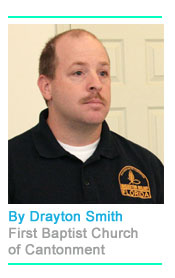 On February 8th I received a call from Florida Disaster Relief wanting a group of four to travel to Haiti for building inspection and Chaplaincy. They wanted us to leave on the 12th. I could not leave that soon so we left on the 17th. At that time no flights were able to go into Port-Au-Prince so we flew into the Dominican Republic. On the 18th we traveled to Haiti by bus. A trip that was about 200 miles would take all day. The roads are inferior to say the least. We left around 4 a.m., as the sun peaks over the mountain range we can see the banana plantations along with the sugar cane fields.
On February 8th I received a call from Florida Disaster Relief wanting a group of four to travel to Haiti for building inspection and Chaplaincy. They wanted us to leave on the 12th. I could not leave that soon so we left on the 17th. At that time no flights were able to go into Port-Au-Prince so we flew into the Dominican Republic. On the 18th we traveled to Haiti by bus. A trip that was about 200 miles would take all day. The roads are inferior to say the least. We left around 4 a.m., as the sun peaks over the mountain range we can see the banana plantations along with the sugar cane fields.
As we approach the border things become very chaotic. It is very crowded and large trucks with supplies are blocking the road way. Our driver goes in to take care of all the paperwork and we are on our way again. The roads continue to be very crowded for quite some time. Check points are set up all along the way. As we get closer to Port au Prince congestion gets worse. We see many military vehicles from all over the world. The streets are filled with people. Some selling fruits and vegetables, others begging for money. All along the edge of the roads we see tents and temporary shelters made from scrap lumber, tin, tarpaulins bearing names like USAID, RED CROSS, and other symbols and emblems. We approach our destination where we will be calling home for the next week. It seems to be in tact. Running off of batteries during the day and a generator to charge the batteries at night. Across the alley we see a home that has collapsed and hear of a 2 year that has lost their life from the falling roof. This hits home with me, I have a two year old.
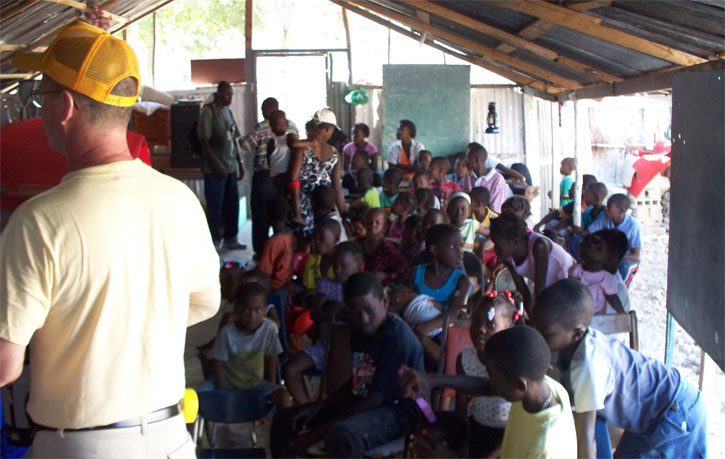 As we get up on our first day we visit with local pastors who welcome us with open arms and somewhat of a smile. We inspect several homes and churches that day. We find out that everyone is petrified to return back into their homes, even if they are safe to go in. “What if it happens again?” That seems to be the question everyone asked. As we pray for those and try to minister to them, we struggle to find the words to say, “its going to be okay.” Its hard because we do not know when and if another quake will happen. Everyone knows someone who lost someone.
As we get up on our first day we visit with local pastors who welcome us with open arms and somewhat of a smile. We inspect several homes and churches that day. We find out that everyone is petrified to return back into their homes, even if they are safe to go in. “What if it happens again?” That seems to be the question everyone asked. As we pray for those and try to minister to them, we struggle to find the words to say, “its going to be okay.” Its hard because we do not know when and if another quake will happen. Everyone knows someone who lost someone.
As the week progresses we meet several new friends from all over the US. They all have come as part of the SBC Disaster Relief. Some are doctors, nurses, pharmacist, others are building inspectors and Chaplains. Each having left their families, jobs and homes to minister to those in need. Over and over I recall the scripture Matthew 22:34-40 “love the Lord and love your neighbor as yourself” (paraphrased). That is what we are doing, Haiti is our neighbor.
 During the week we spend time with parents who have lost children, children who lost parents. We met one lady whose daughter had been kidnapped for seven days before the authorities were able to catch the criminals that took her. We continue to hear the stories of people losing everything. One lady shares of her daughter in nursing school where 300 nurses perished wqhen the roof collapsed. We see where a small hole has been dug out when a 26 year old boy lost his life. I hear from the parent of a nine and three year old who lost their lives. That’s the hard part for me, what to say to these parents.
During the week we spend time with parents who have lost children, children who lost parents. We met one lady whose daughter had been kidnapped for seven days before the authorities were able to catch the criminals that took her. We continue to hear the stories of people losing everything. One lady shares of her daughter in nursing school where 300 nurses perished wqhen the roof collapsed. We see where a small hole has been dug out when a 26 year old boy lost his life. I hear from the parent of a nine and three year old who lost their lives. That’s the hard part for me, what to say to these parents.
There is no equipment at all, men are removing rubble and tearing down buildings with make-shift tools and bare hands. Carrying rocks and busting down walls. It is taking hours and days to do what we could do in just a few minutes in the states with our technology and heavy equipment.
 All we can offer is hope, 1 Peter 5:7 states “cast all your anxiety on Him because He cares for you.” And Philippians 4:19 “My God will meet all your needs according to His glorious riches in Christ Jesus.” What can your offer was our question, Jesus was the answer.
All we can offer is hope, 1 Peter 5:7 states “cast all your anxiety on Him because He cares for you.” And Philippians 4:19 “My God will meet all your needs according to His glorious riches in Christ Jesus.” What can your offer was our question, Jesus was the answer.
While we were there we heard chanting from the voodoo and heard the loud speakers of the Satanist wanting the churches torn down. We kept our eyes on Jesus and shared Him when we could. That was the best comfort for them. (2 Corinthians 1:3-11)
During the nights when the aftershock and tremors would wake us up I would remember the scriptures in Psalm 18 and Isaiah 24 where it speaks of the earth shaking. My mindset was to go and help and be a blessing to the people of Haiti, the blessing was for me. I thank God for how He opened my eyes and provided and protected me.
Photos by Drayton Smith, First Baptist Church of Cantonment, for NorthEscambia..com, click to enlarge.


